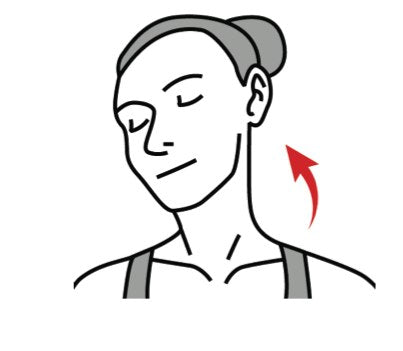Trigger Point Therapy - 5 Great Exercises for a Frozen Shoulder
The Freezing Stage (Phase 1) of a frozen shoulder is a crucial time for starting a gentle stretching regime. Gentle is the operative word.
Your shoulder is likely to be very inflamed at the beginning of this phase but gently stretching the capsule three times per day for five minutes can help stop the adhesions getting too tight.
If you are in too much pain, do as much as you can or stop completely for a few days. Remember to use ice or gels for pain relief.
If you are suffering from a frozen shoulder, hopefully you will be receiving trigger point therapy in the form of the Niel Asher Technique.
As part of your treatment program, your therapist will usually recommend simple exercises to help keep the shoulder mobile.
Here are 5 great exercises that we recommend as they are simple for almost everyone to do at home:
1. Neck Stretching
After performing any exercises it helps to do some neck stretching. With a frozen shoulder, people tend to hold the shoulder in a tense protective posture.
This posture also pulls into the neck muscles causing stiffness and neck pain. Stretching out the neck will also help the neurological output to the shoulder as the nerves supplying the shoulder are in the neck.
Here is an easy stretch to get on with:
• Stand upright in a good posture• Do this 3 times on each side of the neck
If you want to increase the tension, put the hand on the same side as you are stretching onto the head (if you can) and lightly pull to increase the stretch.

2. Capsule Stretching
This important exercise is best done gently in between each treatment session. Start with this passive exercise before you add any weights.
It is very simple but easy to get wrong so please follow the instructions carefully.
• Bend forward at the waist
• Let the affected arm drop towards the floor under its own weight
• Feel the sense of tugging and traction in the shoulder joint
• You can support your other hand on a chair
• Move your body to make the hanging arm swing gently
• Use this method to swing or rock the arm in small to medium-sized clockwise circle
• Perform 3 times daily for 5-8 minutes
Note: You may want to use ice after this

3. Shoulder Shrugging
This can be performed up to five times daily for 2 – 5 minutes. You can move both shoulders at the same time and then independently.
Raise the shoulders up to the neck and push them downwards towards the floor. You can then gently rotate the shoulders in circles together then independently, again, take it nice and slow.
• Shrug your shoulders upwards as high as you can for 8 seconds
• Squeeze the shoulders downwards
• Repeat 3 times

4. Shoulder Rotation
• Keep the hands by the sides
• Rotate the shoulder in a circle
• Repeat on other arm
• Repeat slowly for 2 minutes

5. Pushing the Arm
The way to do it is very simple and can be done almost anywhere:
This is a good exercise to do when trying to relax the muscles of the shoulder.
• Stand upright near a wall or a door frame• Keep your arm hanging straight down
• Push the arm against the door with about 20% of your strength
• Push for ten seconds then relax and repeat 3-4 times
• This can be done both forward, backward and to the side

Frozen Shoulder Exercise Program
Find a Trigger Point Professional in your area
More articles about Shoulder Pain
Nationally Accredited Home-Study Courses
This trigger point blog is intended to be used for information purposes only and is not intended to be used for medical diagnosis or treatment or to substitute for a medical diagnosis and/or treatment rendered or prescribed by a physician or competent healthcare professional. This information is designed as educational material, but should not be taken as a recommendation for treatment of any particular person or patient. Always consult your physician if you think you need treatment or if you feel unwell.
About Niel Asher Education
Niel Asher Education (NAT Global Campus) is a globally recognised provider of high-quality professional learning for hands-on health and movement practitioners. Through an extensive catalogue of expert-led online courses, NAT delivers continuing education for massage therapists, supporting both newly qualified and highly experienced professionals with practical, clinically relevant training designed for real-world practice.
Beyond massage therapy, Niel Asher Education offers comprehensive continuing education for physical therapists, continuing education for athletic trainers, continuing education for chiropractors, and continuing education for rehabilitation professionals working across a wide range of clinical, sports, and wellness environments. Courses span manual therapy, movement, rehabilitation, pain management, integrative therapies, and practitioner self-care, with content presented by respected educators and clinicians from around the world.
Known for its high production values and practitioner-focused approach, Niel Asher Education emphasises clarity, practical application, and professional integrity. Its online learning model allows practitioners to study at their own pace while earning recognised certificates and maintaining ongoing professional development requirements, making continuing education accessible regardless of location or schedule.
Through partnerships with leading educational platforms and organisations worldwide, Niel Asher Education continues to expand access to trusted, high-quality continuing education for massage therapists, continuing education for physical therapists, continuing education for athletic trainers, continuing education for chiropractors, and continuing education for rehabilitation professionals, supporting lifelong learning and professional excellence across the global therapy community.

Continuing Professional Education
Looking for Massage Therapy CEUs, PT and ATC continuing education, chiropractic CE, or advanced manual therapy training? Explore our evidence-based online courses designed for hands-on professionals.



















